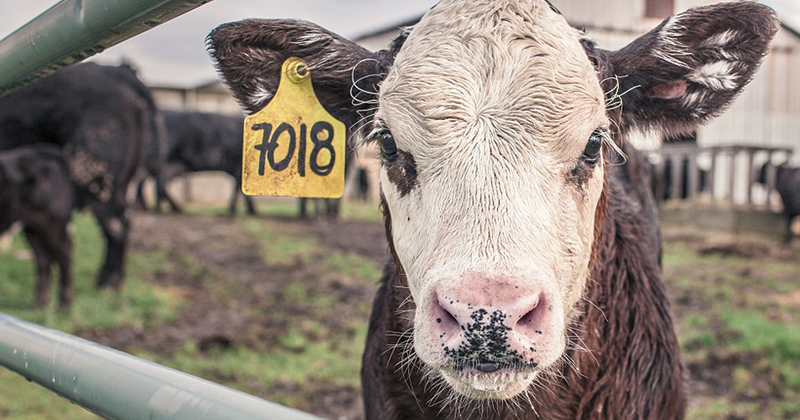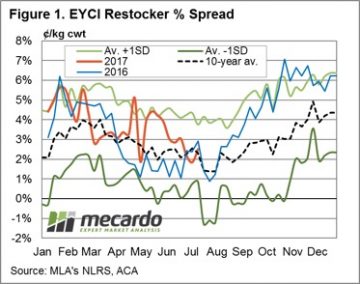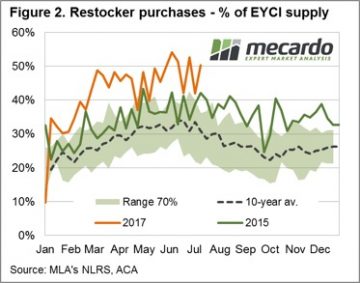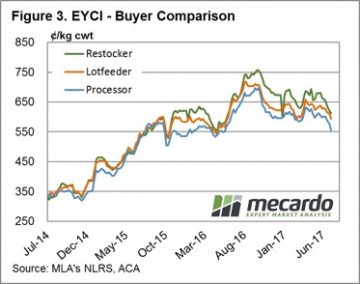Restockers still in the game

 When we set out to write this article, we thought it was going to be about how restocker demand was on the wane, and one of the reasons the cattle market was falling. While restockers are paying less, they are still buying plenty of cattle.
When we set out to write this article, we thought it was going to be about how restocker demand was on the wane, and one of the reasons the cattle market was falling. While restockers are paying less, they are still buying plenty of cattle.
With the dry weather being experienced across much of the east coast, we expected to find restocker demand had been weaker. Figure 1 shows the spread of the price paid by restockers for EYCI cattle, compared to the EYCI itself.
Restockers are not paying as much of a premium as they were, but it has only fallen back to average. Last spring and summer restockers were paying 4-6% more than the EYCI. As the restocker premium eased in March, as did the EYCI. When restocker demand ramped up again, the EYCI rallied, and subsequently fell again, seemingly on the back of the restocker premium falling from 4% to 2%.
With the weakening in the restocker premium, figure 2 shows that restockers are not buying any smaller proportion of cattle. Over the last 9 weeks restockers have bought 49% of EYCI cattle, compared to just 38% over the same period last year. It would seem the falling premium being paid by restockers is more due to increased supplies of suitable cattle.
 This is somewhat confirmed by the smaller fall in the price paid by feeders for EYCI cattle over the last six weeks. Figure 3 shows that feeders are paying 7% less than at the start of June, while restockers are down 10% and processors price have weakened 8%.
This is somewhat confirmed by the smaller fall in the price paid by feeders for EYCI cattle over the last six weeks. Figure 3 shows that feeders are paying 7% less than at the start of June, while restockers are down 10% and processors price have weakened 8%.
It does stand to reason that during dry times more light cattle, suitable for restockers, will come to market. This also means that fewer heavier store cattle suitable feeders will be available, while the supply of finished cattle, for processors will be even weaker.
We are still some way from the drought spreads of 2014-15, when restockers, feeders and processors were all paying the same price.
Key points:
- Dry weather has pushed the EYCI lower, with the restocker premium falling back to average levels.
- Restockers are still buying plenty of EYCI cattle, which suggests supplies of restockers types are higher.
- Widespread rain would see a turnaround in light cattle supply and restocker demand.
What does this mean?
 Stronger supply of light store cattle is not the only reason for the weaker EYCI, but it is contributing. For those lucky enough to have feed on hand, the fact the restocker cattle are now more in line with historical premiums to the EYCI means they are reasonable buying.
Stronger supply of light store cattle is not the only reason for the weaker EYCI, but it is contributing. For those lucky enough to have feed on hand, the fact the restocker cattle are now more in line with historical premiums to the EYCI means they are reasonable buying.
Widespread rainfall on the east coast would see a rapid turnaround in young cattle supply and prices, but there isn’t much encouragement on the forecast. Further dry weather is likely to see the EYCI continue to ease, and the restocker premium fall back to zero.


